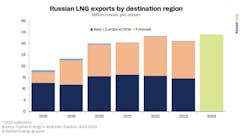Rarely has the outlook for oil markets been more uncertain, said the International Energy Agency (IEA) in its July issue Oil Market Report (OMR).
“A worsening macroeconomic outlook and fears of recession are weighing on market sentiment, while there are ongoing risks on the supply side. For now, weaker-than-expected oil demand growth in advanced economies and resilient Russian supply has loosened headline balances. Benchmark crude futures have tumbled by more than $20/bbl since early June, trading below $100/bbl at the time of writing. Yet, persistent physical crude price tensions and extreme refinery margins highlight underlying imbalances for crude and products supply,” IEA said.
In its latest update, the World Bank warned that Russia’s invasion of Ukraine and its effects on commodity markets, supply chains, inflation and financial conditions have accentuated the slowdown in global economic activity. The bank now expects world GDP growth to ease to 2.9% in 2022 from 5.7% in 2021. The IMF has cautioned that a recession next year cannot be ruled out, given the elevated risks.
Although the deceleration of economic activity is adding further uncertainties to IEA’s oil demand forecast, for now, IEA has only modestly trimmed its outlook for 2022 and 2023.
“High fuel prices have started to dent oil consumption in the OECD, but this was largely countered by a stronger-than-expected demand rebound in emerging and developing economies led by China as it starts to emerge from COVID lockdowns. Oil demand is now expected to expand by 1.7 million b/d in 2022 and 2.1 million b/d next year, when it reaches 101.3 million b/d,” IEA said.
IEA’s forecast was revised slightly higher for oil supply for the remainder of the year due to Russia’s strong performance. In June, global output rose by 690,000 b/d to 99.5 million b/d, as Russia defied sanctions and the US and Canada pumped more.
During June, Russia once again surprised to the upside, delivering the world’s single biggest supply increase as higher domestic consumption far offset lower exports. Total crude oil, condensates and NGL rose 490,000 b/d to reach 11.07 million b/d, down just 330,000 b/d from pre-invasion levels. Gains in June were reportedly mostly due to Rosneft and its Bashneft unit. The ExxonMobil-operated Sakhalin-1 project in the country’s far east saw output of just 10,000 b/d versus 220,000 b/d before Russia invaded Ukraine.
Russian oil exports in June fell by 250,000 b/d month-on-month (m-o-m) to 7.4 million b/d, the lowest since August 2021. This time, the decline was led by crude oil, while product shipments were relatively stable at 2.4 million b/d. Meanwhile, export revenues increased by $700 million m-o-m on higher oil prices, to $20.4 billion, 40% above last year’s average.
“While world oil supply is expected to grow by roughly 1.8 million b/d through December, rising short-term risks to oil supply in Kazakhstan, Libya, and elsewhere have put the spotlight on spare capacity, which now is held primarily by Saudi Arabia and the UAE. Their combined buffer could fall to just 2.2 million b/d in August with the full phase out of record OPEC+ cuts,” IEA said. The OPEC+ group is due to meet on 3 August to chart strategy for September and possibly longer.
Global oil inventories remain critically low, with recent builds concentrated in China, where refiners reduced runs due to weaker demand amid COVID lockdowns. OECD industry stocks have recovered somewhat due to sizeable government stock releases but remain nearly 300 million bbl below their 5-year average.
“As an EU embargo on Russian oil is set to come into full force at the end of the year, the oil market may tighten once again. With readily available spare capacity running low in both the upstream and downstream, it may be up to demand side measures to bring down consumption and fuel costs that pose a threat to stability, most notably in emerging markets. Without strong policy intervention on energy use, risks remain high that the world economy falls off-track for recovery,” IEA said.
Global refinery throughputs rose by 500,000 b/d in June, to 79.2 million b/d, 1.2 million b/d above a year ago. A number of outages and tight spare capacity outside of China meant that product supply failed to keep up with the seasonal increase in demand. Product cracks nevertheless fell from records highs observed in late May but were on average substantially higher on a monthly basis.


